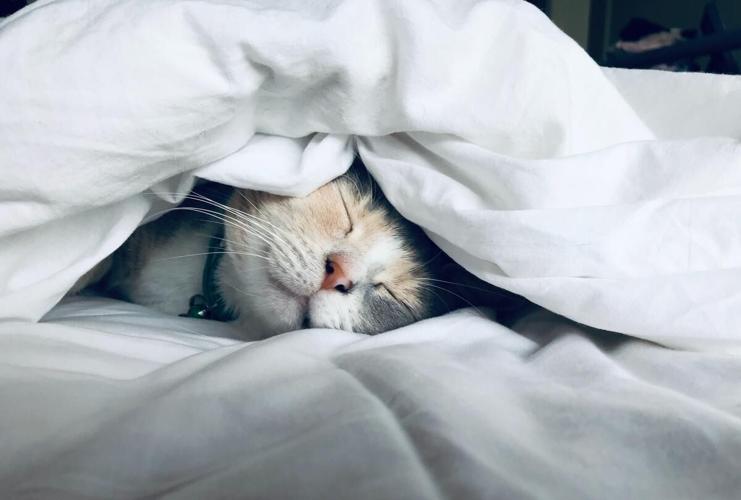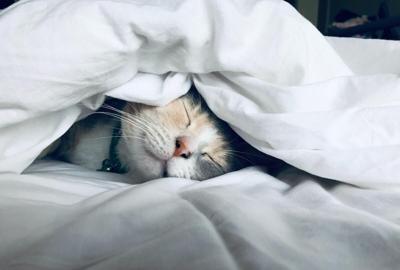Even though we all know perfectly well that autumn doubles as winterŌĆÖs opening act, for many the return of crisp air and cool nights is still a welcome turn of events ŌĆö partly because we associate sweater weather with better sleep.
Others, though, find this the worst time of the year for getting a full eight hours. Despite the fact that experts say temperatures between 15 and 20 C are the sleep sweet spot, the seasonal changes can provoke insomnia in many.
ŌĆ£IŌĆÖm not a great sleeper in general,ŌĆØ said Aja Sax, an instructor at George Brown CollegeŌĆÖs centre for hospitality and culinary arts. ŌĆ£From the moment my head hits the pillow, it usually takes me about 45 minutes to fall asleep. This time of year, though, itŌĆÖs more like two hours.ŌĆØ
Sax also noted that she wakes up more in the middle of the night in the early days of fall. This usually lasts about three weeks, then goes away until just before the winter solstice when her insomnia returns.
ŌĆ£I think itŌĆÖs the change in light more than anything,ŌĆØ she added. ŌĆ£It always happens to me in the shoulder seasons. I feel like my brain turns on the moment I get into bed.ŌĆØ
According to sleep expert Jennifer Barbera, a psychologist with a practice in Hamilton that , many Canadians share SaxŌĆÖs problem.
ŌĆ£We definitely see an increase in people reaching out for services in the fall,ŌĆØ said Barbera, ŌĆ£Sometimes, in the summer, people have more energy, stay up later and are more relaxed so, in the fall, they find it hard to go back to a more structured routine.ŌĆØ
For some, like Sax, itŌĆÖs a matter of adjusting to the change in seasons or situational stresses. Others, though, might be on the cusp of more serious sleep disorders, so itŌĆÖs important to know how serious the problem is and get a proper sleep evaluation by a professional.
ŌĆ£We all have nights when we wake up and it takes a long time to fall back to sleep,ŌĆØ noted Dr. Dora Zalai, an MD and clinical psychologist at TorontoŌĆÖs , a practice focused on psychological and medical improvements to sleep.
ŌĆ£This period may last for a few days or a period of a few weeks and then it goes away,ŌĆØ Zalai added, noting that itŌĆÖs important to distinguish this pattern from chronic insomnia.
ŌĆ£Chronic insomnia means difficulty falling asleep and/or staying asleep for at least three nights per week for at least a three-month-long period,ŌĆØ said Zalai. ŌĆ£It usually has a daytime impact as well and affects a personŌĆÖs well-being in some way, such as causing distress, fatigue or mood problems.ŌĆØ
ItŌĆÖs still probably not a great idea to self-diagnose, since Zalai noted that occasional insomnia can develop into chronic sleep problems. In addition, some people suffer from entirely different, undiagnosed, sleep disorders, including sleep apnea, peri-menopause-related sleep problems and even circadian rhythm disorders.
Clearly, when it comes to sleep, thereŌĆÖs no one-size-fits-all solution and there are a range of solutions therapists use to treat sleep problems.

ŌĆ£You often read things like ŌĆśhave a dark bedroomŌĆÖ, ŌĆśdon’t exercise right before bedŌĆÖ or ŌĆśdon’t drink too much tea in the daytimeŌĆÖ,ŌĆØ said Dr. Dora Zalai, a ║ŻĮŪ╔ńŪ°╣┘═°clinical psychologist. ŌĆ£This sort of advice is called sleep hygiene and might work for someone with occasional problems but is not a treatment for a person with a sleep disorder.ŌĆØ
UnsplashOf the two main therapeutic frameworks in use these days, the front-line recommendation for treatment of chronic insomnia is cognitive behavioural therapy for insomnia (CBT-I). The second, less popular, but gaining ground is acceptance and commitment therapy for insomnia (ACT-I). Although they share common aspects, thereŌĆÖs one way in which they are distinct from each other.
ŌĆ£CBT-I tends to focus on more of a medical model that works on getting rid of symptoms,ŌĆØ said Barbera, ŌĆ£while by contrast, ACT-I is about changing the relationship we have with our symptoms and learning to accept them.
ŌĆ£We know if we can untangle the struggle we have with our symptoms, that will help to actually improve the symptoms themselves.ŌĆØ
Barbera pointed out that ACT is rooted in the concept of ŌĆ£psychological flexibility,ŌĆØ which often involves learning to sit with uncomfortable emotions and observe them, as opposed to fighting them off.
Enjoy your symptoms? Well, that might be taking it too far. ŌĆ£How I learned to stop worrying and live with my insomnia,ŌĆØ though, is in the right ballpark.
This all might ring a bell to people who practise mindfulness, which also tries to nudge people away from actively working on changing their thought patterns and, instead, invites people to accept and become curious about them.
Both of these therapeutic options take some time and commitment but, for anyone who is suffering from chronic insomnia, itŌĆÖs important to get a medical evaluation and help from an expert ŌĆö not just advice from a listicle on how to get better sleep.
ŌĆ£You often read things like ŌĆśhave a dark bedroom,ŌĆÖ ŌĆśdonŌĆÖt exercise right before bedŌĆÖ or ŌĆśdonŌĆÖt drink too much tea in the daytime,ŌĆÖŌĆØ said Zalai. ŌĆ£This sort of advice is called sleep hygiene and might work for someone with occasional problems but is not a treatment for a person with a sleep disorder.ŌĆØ
Zalai added that, in clinical trials for chronic insomnia, researchers often use sleep hygiene as a placebo in the control group.
ŌĆ£People read these things online and try them but, if they have a chronic insomnia condition, sleep hygiene will not resolve it. And thatŌĆÖs where a lot of people get stuck.ŌĆØ






























To join the conversation set a first and last name in your user profile.
Sign in or register for free to join the Conversation